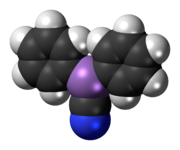Diphenylcyanoarsine
 |
|
 |
|
| Names | |
|---|---|
|
Preferred IUPAC name
Diphenylarsinous cyanide
|
|
|
Systematic IUPAC name
Diphenylarsanecarbonitrile
|
|
| Other names
Clark 2
Diphenylarsinecarbonitrile |
|
| Identifiers | |
|
23525-22-6 |
|
| 3D model (Jmol) |
Interactive image Interactive image |
| ChemSpider |
58070 |
| ECHA InfoCard | 100.041.545 |
| EC Number | 245-716-6 |
| MeSH | Clark+2 |
| PubChem | 64506 |
|
|
|
|
| Properties | |
| C13H10AsN | |
| Molar mass | 255.002920742 g mol−1 |
|
Except where otherwise noted, data are given for materials in their standard state (at 25 °C [77 °F], 100 kPa).
|
|
| Infobox references | |
Diphenylarsinecarbonitrile
Diphenylarsine cyanide
Di(phenyl)arsanylformonitrile
Diphenylcyanoarsine, also called Clark 2 (Chlor-Arsen-Kampfstoff 2, being the successor of Clark 1) by the Germans, was discovered in 1918 by Sturniolo and Bellinzoni and shortly thereafter used like the related Clark 1 gas by the Germans for chemical warfare in the First World War. The substance causes nausea, vomiting and headaches. It can subsequently lead to e.g. pulmonary oedema (fluid on the lungs).
...
Wikipedia
